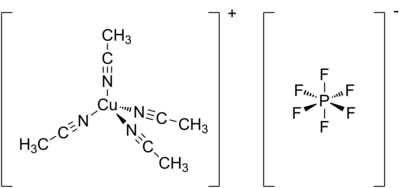
Search
Transition metal nitrile complexes

Transition metal nitrile complexes are coordination compounds containing nitrile ligands. Because nitriles are weakly basic, the nitrile ligands in these complexes are often labile.
Scope of nitriles
Typical nitrile ligands are acetonitrile, propionitrile, and benzonitrile. The structures of [Ru(NH3)5(NCPh)]n+ have been determined for the 2+ and 3+ oxidation states. Upon oxidation the Ru-NH3 distances contract and the Ru-NCPh distances elongate, consistent with amines serving as pure-sigma donor ligands and nitriles functioning as pi-acceptors.
Synthesis and reactions
Acetonitrile, propionitrile and benzonitrile are also popular solvents. Because nitrile solvents have high dielectric constants, cationic complexes containing a nitrile ligand are often soluble in a solution of that nitrile.
Some complexes can be prepared by dissolving an anhydrous metal salt in the nitrile. In other cases, a suspension of the metal is oxidized with a solution of NOBF4 in the nitrile:
- Ni + 6 MeCN + 2 NOBF4 → [Ni(MeCN)6](BF4)2 + 2 NO
Heteroleptic complexes of molybdenum and tungsten can by synthesized from their respective hexacarbonyl complexes.
- M(CO)6 + 4 MeCN + 2 NOBF4 → [M(NO)2(MeCN)4](BF4)2
For the synthesis of some acetonitrile complexes, the nitrile serves as a reductant. This method is illustrated by the conversion of molybdenum pentachloride to the molybdenum(IV) complex:
- 2 MoCl5 + 5 CH3CN → 2 MoCl4(CH3CN)2 + ClCH2CN + HCl
Reactions
Transition metal nitrile complexes are usually employed because the nitrile ligand is labile and relatively chemically inert. Cationic nitrile complexes are however susceptible to nucleophilic attack at carbon. Consequently some nitrile complexes catalyze the hydrolysis of nitriles to give the amides.
Fe- and Co-nitrile complexes are intermediates in nitrile hydratase enzymes. N-coordination activates the sp-hybridized carbon center toward attack by nucleophiles, including water. Thus coordination of the nitrile to a cationic metal center is the basis for the catalytic hydration:
- M-NCR + H2O → M-O=C(NH2)R
- M-O=C(NH2)R + NCR → O=C(NH2)R + M-NCR
Nitrile ligands in electron-rich complexes are susceptible to oxidation, e.g. by iodosylbenzene. Nitriles undergo coupling with alkenes, also involving electron-rich complexes.
Examples
[M(NCMe)6]n+
- Hexakis(acetonitrile)vanadium(II) tetrachlorozincate ([V(MeCN)6](ZnCl4)), green
- Hexakis(acetonitrile)chromium(II) bis(tetraphenylborate) ([Cr(MeCN)6](B(C6H5)4)2, green
- Hexakis(acetonitrile)chromium(III) tetrafluoroborate ([Cr(MeCN)6](BF4)3), white
- Hexakis(acetonitrile)iron(II) bis(tetrakis(pentafluorophenyl)borate) ([Fe(MeCN)6](B(C6F5)4)2, orange
- Hexakis(acetonitrile)cobalt(II) bis(tetrakis(pentafluorophenyl)borate) ([Co(MeCN)6](B(C6F5)4)2, purple
- Hexakis(acetonitrile)nickel(II) tetrafluoroborate ([Ni(MeCN)6](BF4)2), blue
- Hexakis(acetonitrile)copper(II) bis(tetrakis(pentafluorophenyl)borate) ([Cu(MeCN)6](B(C6F5)4)2, pale blue-green solid
- Hexakis(acetonitrile)ruthenium(II) tetrafluoroborate ([Ru(MeCN)6](BF4)2), white, dRu-N = 202 pm.
- Hexakis(acetonitrile)rhodium(III) tetrafluoroborate ([Rh(MeCN)6](BF4)3), a yellow solid.
- Hexakis(acetonitrile)rhenium(II) tetrafluoroborate ([Re(MeCN)6](BF4)2), a yellow solid.
- Hexakis(acetonitrile)rhenium(III) tetrafluoroborate ([Re(MeCN)6](BF4)3), a brown solid.
[M(NCMe)4]n+
- [Cr(MeCN)4](BF4)2, blue
- [Cu(MeCN)4]PF6, colorless
- [Pd(MeCN)4](BF4)2, yellow
[M(NCMe)4 or 5]2n+
- [Mo2(MeCN)8/10](BF4)4 blue d(Mo-Mo) = 218, d(Mo-N)axial = 260, d(Mo-N)equat = 214 pm
- [Tc2(MeCN)10](BF4)4
- [Re2(MeCN)10][B(C6H3(CF3)2)4]2, blue; d(Re-Re) = 226, d(Re-N)axial = 240, d(Re-N)equat = 205 pm
- [Rh2(MeCN)10](BF4)4, orange; d(Rh-Rh) = 261, d(Re-N)axial = 219, d(Re-N)equat = 198 pm
[M(NCMe)2]+
- [Ag(MeCN)2]B(C6H3(CF3)2)4
- [Au(MeCN)2]SbF6
Mixed ligand examples
- Bis(benzonitrile)palladium dichloride (PdCl2(PhCN)2), an orange solid that serves as a source of "PdCl2"
- Tricarbonyltris(propionitrile)molybdenum(0) (Mo(CO)3(C2H5CN)3), a source of "Mo(CO)3". Related Cr and W complexes are known.
Complexes of η2-nitrile ligands
In some of its complexes, nitriles function as η2-ligands. This bonding mode is more common for complexes of low-valence metals, such as Ni(0). Complexes of η2-nitriles are expected to form as transient intermediates in certain metal-catalyzed reactions of nitriles, such as the Hoesch reaction and the hydrogenation of nitriles. In some cases, η2-nitrile ligands are intermediates that preceded oxidative addition.
See also
- Cyanometalate – coordination compounds containing cyanide ligands (coordinating via C).
References
Text submitted to CC-BY-SA license. Source: Transition metal nitrile complexes by Wikipedia (Historical)
Articles connexes
- Nitrile
- Transition metal isocyanide complexes
- Transition metal carbyne complex
- Acetonitrile
- Tetrakis(acetonitrile)copper(I) hexafluorophosphate
- Tetrafluoroborate
- Cyanide
- Cyanometalate
- Metal nitrido complex
- Photoredox catalysis
- Nitrile anion
- Hydrogenation
- Benzonitrile
- Metal–organic framework
- Alkyne metathesis
- Evolution of metal ions in biological systems
- 1,3-Dipolar cycloaddition
- (1,1'-Bis(diphenylphosphino)ferrocene)palladium(II) dichloride
- Trisodium dicarboxymethyl alaninate
- Silver
Owlapps.net - since 2012 - Les chouettes applications du hibou


